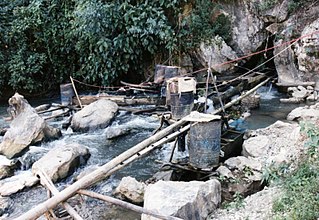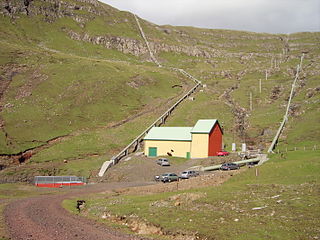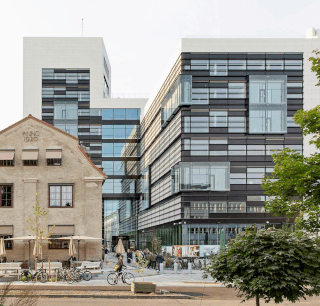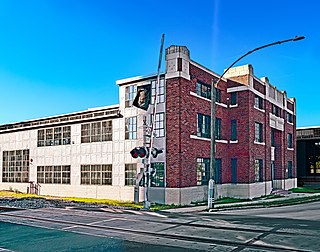
Hydropower, also known as water power, is the use of falling or fast-running water to produce electricity or to power machines. This is achieved by converting the gravitational potential or kinetic energy of a water source to produce power. Hydropower is a method of sustainable energy production. Hydropower is now used principally for hydroelectric power generation, and is also applied as one half of an energy storage system known as pumped-storage hydroelectricity.

A water turbine is a rotary machine that converts kinetic energy and potential energy of water into mechanical work.

Hydroelectricity, or hydroelectric power, is electricity generated from hydropower. Hydropower supplies one sixth of the world's electricity, almost 4,500 TWh in 2020, which is more than all other renewable sources combined and also more than nuclear power. Hydropower can provide large amounts of low-carbon electricity on demand, making it a key element for creating secure and clean electricity supply systems. A hydroelectric power station that has a dam and reservoir is a flexible source, since the amount of electricity produced can be increased or decreased in seconds or minutes in response to varying electricity demand. Once a hydroelectric complex is constructed, it produces no direct waste, and almost always emits considerably less greenhouse gas than fossil fuel-powered energy plants. However, when constructed in lowland rainforest areas, where part of the forest is inundated, substantial amounts of greenhouse gases may be emitted.

The Francis turbine is a type of water turbine. It is an inward-flow reaction turbine that combines radial and axial flow concepts. Francis turbines are the most common water turbine in use today, and can achieve over 95% efficiency.
Kværner was a Norwegian engineering and construction services company that existed between 1853 and 2005. In 2004, it was amalgamated into the newly formed subsidiary of Aker ASA - Aker Kværner, which was renamed Aker Solutions on 3 April 2008. Kværner re-emerged on 6 May 2011, when the EPC part of Aker Solutions took the Kværner name. The new Kværner company was listed on the Oslo Stock Exchange on 8 July 2011.

Aker Solutions ASA engineers and builds energy infrastructure while providing a range of products and consultancy services to low-carbon and renewable energy projects. Based in Oslo, the company's critical offerings to the energy industry include the systems and services required to de-carbonize oil and gas production, build wind-to-grid infrastructure and engineer CO2 capture and sequestration.

Micro hydro is a type of hydroelectric power that typically produces from 5 kW to 100 kW of electricity using the natural flow of water. Installations below 5 kW are called pico hydro. These installations can provide power to an isolated home or small community, or are sometimes connected to electric power networks, particularly where net metering is offered. There are many of these installations around the world, particularly in developing nations as they can provide an economical source of energy without the purchase of fuel. Micro hydro systems complement solar PV power systems because in many areas water flow, and thus available hydro power, is highest in the winter when solar energy is at a minimum. Micro hydro is frequently accomplished with a pelton wheel for high head, low flow water supply. The installation is often just a small dammed pool, at the top of a waterfall, with several hundred feet of pipe leading to a small generator housing. In low head sites, generally water wheels and Archimedes' screws are used.
The Voith Group is a German multinational technology company with a broad portfolio of systems, products, services and digital applications. Voith works in the markets of energy, paper, raw materials and transport & automotive. Founded in 1867, the company today has around 22,479 employees, sales of €5.5 billion and locations in over 60 countries worldwide and is thus one of the larger family-owned companies in Europe.

The Botnur power plant is a hydroelectric power station supplying the Faroe Islands' southernmost island of Suðuroy with electricity. It is located to the north of Vágur. Botnur was the first hydroelectric plant built in the Faroes.

Vetco was established in July 2004 and operated through its subsidiaries Vetco Gray and Vetco Aibel AS. Vetco was the result of a consortium consisting of the private equity firms Candover, 3i and JP Morgan Partners taking over ABB's oil and gas division; ABB Offshore Systems. Vetco was made out of companies that have serviced the upstream oil and gas industry since 1903. These companies are suppliers of products, systems and services for onshore and offshore drilling and production, project management, engineering, procurement and construction services, process systems and equipment, maintenance, modification and operations. Vetco was headquartered in London UK, and employed over 10,000 people in more than 30 countries worldwide.

Stewart & Stevenson is a manufacturer and distributor of products and services for the oil and gas, marine, construction, power generation, transportation, mining and agricultural industries.

Hafslund AS is a group with ownership within the power industry. The group is fully owned by Oslo municipality. Hafslund's core business streams are hydropower, with 56 percent ownership in Norway's second largest hydropower company Hafslund Eco AS, and district heating, as majority shareholder in Norway's largest district heating company Hafslund Oslo Celsio AS. The group also owns 50 percent of Eidsiva Energi and thereby 50 percent of Norway's grid company Elvia, as well as broadband and bio heat. Hafslund AS also owns 49 percent of Fredrikstad Energi AS. The group has also ownership in Hafslund New Energy with operations within electrification and Hafslund is one of three partners in the offshore wind partnership Blåvinge together with Fred. Olsen Renewables and Ørsted.

The Caruachi Dam is a concrete gravity dam on the Caroní River in Bolivar state, Venezuela. It supports a hydroelectric power facility with a 2,160 megawatts (2,900,000 hp) capacity. It is about 59 kilometres (37 mi) downstream from the Guri Dam belonging to the Central Hidroeléctrica Simón Bolívar, and about 35 kilometres (22 mi) from where the Caroni and Orinoco rivers meet at Ciudad Guayana.

Andritz AG is an international technology group, offering plants, equipment, systems and services for various industries. The group's headquarters are in Graz, Austria. The group gets its name from the district of Andritz in which it is located and is listed on the Vienna Stock Exchange.
Low-head hydropower refers to the development of hydroelectric power where the head is typically less than 20 metres, although precise definitions vary. Head is the vertical height measured between the hydro intake water level and the water level at the point of discharge. Using only a low head drop in a river or tidal flows to create electricity may provide a renewable energy source that will have a minimal impact on the environment. Since the generated power is a function of the head these systems are typically classed as small-scale hydropower, which have an installed capacity of less than 5MW.

Cameron International Corporation (formerly Cooper Cameron Corporation (CCC) and Cooper Oil Tool, Cameron Iron Works) though now operating under Schlumberger, is a global provider of pressure control, production, processing, and flow control systems as well as project management and aftermarket services for the oil and gas and process industries. Cameron was acquired by Schlumberger (SLB) in 2016, and now operates as 'Cameron, an SLB Company.' At the start of the SLB acquisition in 2015, Cameron employed approximately 23,000 people and delivered $9.8 billion in revenue.
Conduit hydroelectricity is a method of using mechanical energy of water as part of the water delivery system through man-made conduits to generate electricity. Generally, the conduits are existing water pipelines such as in public water supply. Some definitions expand the definition of conduits to be existing tunnels, canals, or aqueducts that are used primarily for other water delivery purposes than electricity generation.

Torstein Dale Sjøtveit is a Norwegian business executive. Torstein is currently executive chairman of Freyr AS, a Norwegian company aiming at establishing a 32 GWh Giga factory for lithium battery cells in Mo I Rana Norway.

GE Oil & Gas was the division of General Electric that owned its investments in the petroleum industry. In July 2017, this division was merged with Baker Hughes.
Micro hydropower to generate electricity in Nepal started with Pharping plant with an installed capacity of 500 kW in 1911 followed by Sundarijal and Panauti, in 1936 and 1965 respectively. Up to 1980, the focus was laid primarily on large-scale power generation through large hydro and thermal means, the micro-hydro potential remained untapped. In the first four years (1981–1985), the government started subsidising the micro-hydro plants. The number of plants has been increasing thereafter. Most of these plants are off-grid isolated plants serving for local villages. In 2000, Alternative Energy Promotion Centre was formed to look after the micro-hydropower in Nepal. It defined the plants in the range of 10-100 kW as micro hydropower. As of 2018, about 3000 microhydro projects have been installed contributing about 35 MW.














